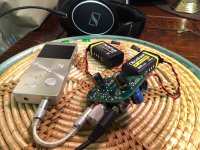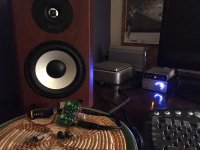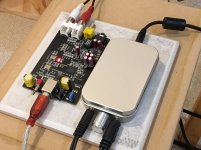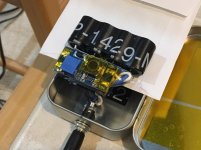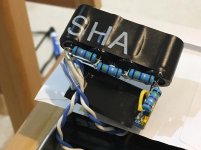Hey X, any more boards left? was thinking of getting another two to muck around with
Sure, plenty more available. PM me with your PayPal account and number of boards and ship address. Price for two is now $20 and includes tracked shipping in US.
Or you can also order pre-soldered SMT boards from my shop. They have matched FETs and all the SMT parts reflow soldered and tested to work. Then you can have fun playing with cap rolling or installing in a desktop case with flying leads to panel mount jacks, pots, etc. A good option for those not digging the SMT soldering.
https://www.etsy.com/shop/XRKAudio
Firstly the amp will just power off intermittently when being handled. It turned out to be power socket loosing connection from the laptop brick. Must be an inferior type socket. Easy to fix.
Then, the amp suddenly started distorting in the one channel. The distortion is only present when music plays, and goes up and down with the volume. When the volume is very loud it is difficult to hear it, but in quiet moments the distortion is very audible.
I don’t think (or hope) these problems are related. My guess is that the distortion is suspect soldering, but where to start looking? The other possibility is one of the 3.5mm sockets maybe – they are also cheap and inferior looking compared to the gold plated (RCA and jack) sockets I used on previous amps.
Any thoughts on what could cause this?
Elna Silmic II vs. Nichicon Muse KZ
After several hours listening back and forth between the 47uF Silmic II and Muse KZ on output bypass duty in the PCA amp, I can say with confidence that the two caps sound quite distinct in this application. Different beasts altogether.
I am not auditioning these caps on their own. They are bypassing my existing 470uF Nichicon KA output caps, so synergy is likely a factor. Also, the Silmic has the slight advantage of a 35V rating vs. the 25V Muse, but the caps are the same capacitance and have identical physical dimensions, so I feel the comparison is reasonable. I used both my xDuoo X3 DAP and Echo Audiofire soundcard as sources, using the Pocket Class A to power my Sennheiser HD598 headphones and also as a preamp, feeding my Tripath-powered Axiom Audio M3 speakers.
Silmic
As I explained in my earlier post, the Silmic tames the upper mids and low treble in a very smooth and musical way, by “damping” the resonances of the upper frequencies. The easiest way I can describe this sound is to say that notes with a lot of information in the midrange and low treble seem to buzz less and decay faster, lending a certain sense of control and wonderful transparency, as notes pop up and then sink rapidly into a dark background. This is nice and easy on the ears, but I notice that percussion can sound ever-so-slightly hollow and vocals a tad recessed in the mids as a result…smooth but perhaps harmonically incomplete. There is nice air on top, above the threshold of this effect. Synth pads emerge glassy and ghostlike from a cool, serene atmosphere in "Monument" by Robyn. Somehow this squeaky clean sound adds an amazing depth to the soundstage. I can listen "in" to the music more, and I can hear Amos Lee moving closer and further from the microphone as he sings "Bottom of the Barrel", creating a 3-D soundstage. What's more…his foot stomps in the beginning of the song sound convincingly deep. There is tight control, speed, and clarity in the bass registers, with superb weight all the way down to sub-bass. With complex and difficult material, like the rapid dynamic cliffs in the Futuristics remix of "Moonshine" by Bruno Mars, the Silmic keeps its composure, allowing the necessary breathing room in the mix for instrument separation and good dynamics.
Muse
The Muse lets everything through. In fact, my amp is subjectively louder with them in place. But volume isn’t the main difference…even if I dial it back, I can hear it. It lifts a veil and adds warmth. Presence, detail, and dynamics are off the chain. The snare drum in “The Bird” by Anderson .Paak simply hits faster and harder, with immediacy and sharp coherence. On top of that, I can now follow the long decay of its reverb tail all the way back down to the noise floor. Micro-details like the triangle “ting” in Daft Punk’s “Give Live Back to Music” come flying out of the mix…whereas I didn’t even notice them with the Silmic. Cymbals and chimes have a hyper-realistic timbre, with all their metallic harmonics beautifully apparent. Unfortunately this tizz carries over into vocal peaks and other sounds as well. While not the cleanest ever, the vocals are awesomely fun…in your face in a most engaging way with the KZ. Voices pop out of the mix with midrange presence, detail, and unabashed sparkle. The fat analog synth lead of Miike Snow's "Black and Blue" rips through the air like electricity…amazing. Bass is powerful, with more overall quantity than the Silmic, but sadly it is a bit less extended, and muddy in comparison. Every sound drips with texture and commands attention…it's like the notes are singing directly into my head. This can come off as compressed and fatiguing with complex material, but with simple arrangements, like Norah Jones' "Burn", the immediacy and realism of her performance is stunning.
Think of it this way:
The Silmic II is Gandalf's sword, Glamdring. Meticulously crafted, it has the heft to deliver solid bass thump and its sound is honed perfectly smooth, delivering balance and extension. Its enchanted blade cooly illuminates musical space, yielding a cool and calm atmosphere, even in the midst of musical chaos.
The Muse KZ is Kilo Ren's lightsaber. Red-hot, it hums with extreme harmonic texture and deals electrifying mids and treble. Every last detail cuts effortlessly through the mix with speed and warmth. But its brute resolving power can sound a touch unrefined (i.e. more distortion), and deep down, it's a little unsure in the bass.
I have actually had a hard time deciding which one I like more. They both bring out different nuances. My musician buddy who had a listen said he preferred vocals on the KZ but overall presentation with the Silmic. He joked that he wants me to build him an amp with a switch to toggle between caps! By the way, the green caps in the second photo are Muse ES bipolars. I left them out because they really didn't do anything audible as bypass caps.
After several hours listening back and forth between the 47uF Silmic II and Muse KZ on output bypass duty in the PCA amp, I can say with confidence that the two caps sound quite distinct in this application. Different beasts altogether.
I am not auditioning these caps on their own. They are bypassing my existing 470uF Nichicon KA output caps, so synergy is likely a factor. Also, the Silmic has the slight advantage of a 35V rating vs. the 25V Muse, but the caps are the same capacitance and have identical physical dimensions, so I feel the comparison is reasonable. I used both my xDuoo X3 DAP and Echo Audiofire soundcard as sources, using the Pocket Class A to power my Sennheiser HD598 headphones and also as a preamp, feeding my Tripath-powered Axiom Audio M3 speakers.
Silmic
As I explained in my earlier post, the Silmic tames the upper mids and low treble in a very smooth and musical way, by “damping” the resonances of the upper frequencies. The easiest way I can describe this sound is to say that notes with a lot of information in the midrange and low treble seem to buzz less and decay faster, lending a certain sense of control and wonderful transparency, as notes pop up and then sink rapidly into a dark background. This is nice and easy on the ears, but I notice that percussion can sound ever-so-slightly hollow and vocals a tad recessed in the mids as a result…smooth but perhaps harmonically incomplete. There is nice air on top, above the threshold of this effect. Synth pads emerge glassy and ghostlike from a cool, serene atmosphere in "Monument" by Robyn. Somehow this squeaky clean sound adds an amazing depth to the soundstage. I can listen "in" to the music more, and I can hear Amos Lee moving closer and further from the microphone as he sings "Bottom of the Barrel", creating a 3-D soundstage. What's more…his foot stomps in the beginning of the song sound convincingly deep. There is tight control, speed, and clarity in the bass registers, with superb weight all the way down to sub-bass. With complex and difficult material, like the rapid dynamic cliffs in the Futuristics remix of "Moonshine" by Bruno Mars, the Silmic keeps its composure, allowing the necessary breathing room in the mix for instrument separation and good dynamics.
Muse
The Muse lets everything through. In fact, my amp is subjectively louder with them in place. But volume isn’t the main difference…even if I dial it back, I can hear it. It lifts a veil and adds warmth. Presence, detail, and dynamics are off the chain. The snare drum in “The Bird” by Anderson .Paak simply hits faster and harder, with immediacy and sharp coherence. On top of that, I can now follow the long decay of its reverb tail all the way back down to the noise floor. Micro-details like the triangle “ting” in Daft Punk’s “Give Live Back to Music” come flying out of the mix…whereas I didn’t even notice them with the Silmic. Cymbals and chimes have a hyper-realistic timbre, with all their metallic harmonics beautifully apparent. Unfortunately this tizz carries over into vocal peaks and other sounds as well. While not the cleanest ever, the vocals are awesomely fun…in your face in a most engaging way with the KZ. Voices pop out of the mix with midrange presence, detail, and unabashed sparkle. The fat analog synth lead of Miike Snow's "Black and Blue" rips through the air like electricity…amazing. Bass is powerful, with more overall quantity than the Silmic, but sadly it is a bit less extended, and muddy in comparison. Every sound drips with texture and commands attention…it's like the notes are singing directly into my head. This can come off as compressed and fatiguing with complex material, but with simple arrangements, like Norah Jones' "Burn", the immediacy and realism of her performance is stunning.
Think of it this way:
The Silmic II is Gandalf's sword, Glamdring. Meticulously crafted, it has the heft to deliver solid bass thump and its sound is honed perfectly smooth, delivering balance and extension. Its enchanted blade cooly illuminates musical space, yielding a cool and calm atmosphere, even in the midst of musical chaos.
The Muse KZ is Kilo Ren's lightsaber. Red-hot, it hums with extreme harmonic texture and deals electrifying mids and treble. Every last detail cuts effortlessly through the mix with speed and warmth. But its brute resolving power can sound a touch unrefined (i.e. more distortion), and deep down, it's a little unsure in the bass.
I have actually had a hard time deciding which one I like more. They both bring out different nuances. My musician buddy who had a listen said he preferred vocals on the KZ but overall presentation with the Silmic. He joked that he wants me to build him an amp with a switch to toggle between caps! By the way, the green caps in the second photo are Muse ES bipolars. I left them out because they really didn't do anything audible as bypass caps.
Attachments
My amp suddenly developed two problems.
Firstly the amp will just power off intermittently when being handled. It turned out to be power socket loosing connection from the laptop brick. Must be an inferior type socket. Easy to fix.
Then, the amp suddenly started distorting in the one channel. The distortion is only present when music plays, and goes up and down with the volume. When the volume is very loud it is difficult to hear it, but in quiet moments the distortion is very audible.
I don’t think (or hope) these problems are related. My guess is that the distortion is suspect soldering, but where to start looking? The other possibility is one of the 3.5mm sockets maybe – they are also cheap and inferior looking compared to the gold plated (RCA and jack) sockets I used on previous amps.
Any thoughts on what could cause this?
DIYrookie, I don't want to bury your post. Good luck finding the culprit for your distortion issue.
My amp suddenly developed two problems.
Firstly the amp will just power off intermittently when being handled. It turned out to be power socket loosing connection from the laptop brick. Must be an inferior type socket. Easy to fix.
Then, the amp suddenly started distorting in the one channel. The distortion is only present when music plays, and goes up and down with the volume. When the volume is very loud it is difficult to hear it, but in quiet moments the distortion is very audible.
I don’t think (or hope) these problems are related. My guess is that the distortion is suspect soldering, but where to start looking? The other possibility is one of the 3.5mm sockets maybe – they are also cheap and inferior looking compared to the gold plated (RCA and jack) sockets I used on previous amps.
Any thoughts on what could cause this?
Please measure with respect to GND, DC voltage at pin 1, 2, 3 at mosfet of good and bad channel. Measure voltage drop across R3. Voltage of pin3 tells us bias current and voltage drop across R3 tells is JFET bias. When bias current is too low, you will get distortion. So a bad joint may cause low voltage which may cause audible distortion.
stellar elephant, what about KZ bypassed with silmic or the other way around?
should net you the best of both?
Or the worst of both, lol. I need to keep the KA for bass, so that would be three electros in parallel. Crazy idea. I think they'd all fit though. I'll give it a shot.
By the way, this amp sounds really good with all of the caps I've tried. Beats the pants off the built-in amp in my portable player and even slays the headphone output of my computer audio interface.
Last edited:
Who Says a Main Preamp Needs to be Big?
I am now using this as a workhorse preamp for my big Class AB power amps. It's a Pocket Class A but instead of 9v batteries, I have a DC-DC step up converter (1.2Mhz switch freq) and a RCRCRC (0.47R//2200uF) filter inside giving the amp a solid 17v regulated ultra-low noise power supply. I am using a 12v 3amp SMPS from an old external HDD to power it (don't need all the amps but it's what I had). Here it is sitting next to my XMOS U8//BB PCM5102A DAC. It's a nice combo - dead silent noise floor and great musicality and dynamics. With a 3ohm output impedance and ability to drive 10v peak-peak, it can pretty much drive any amplifier to clipping, all while doing so with a wonderful SE Class A harmonic profile. This particular unit has -72dB H2 and -84dB H3 and nothing else.
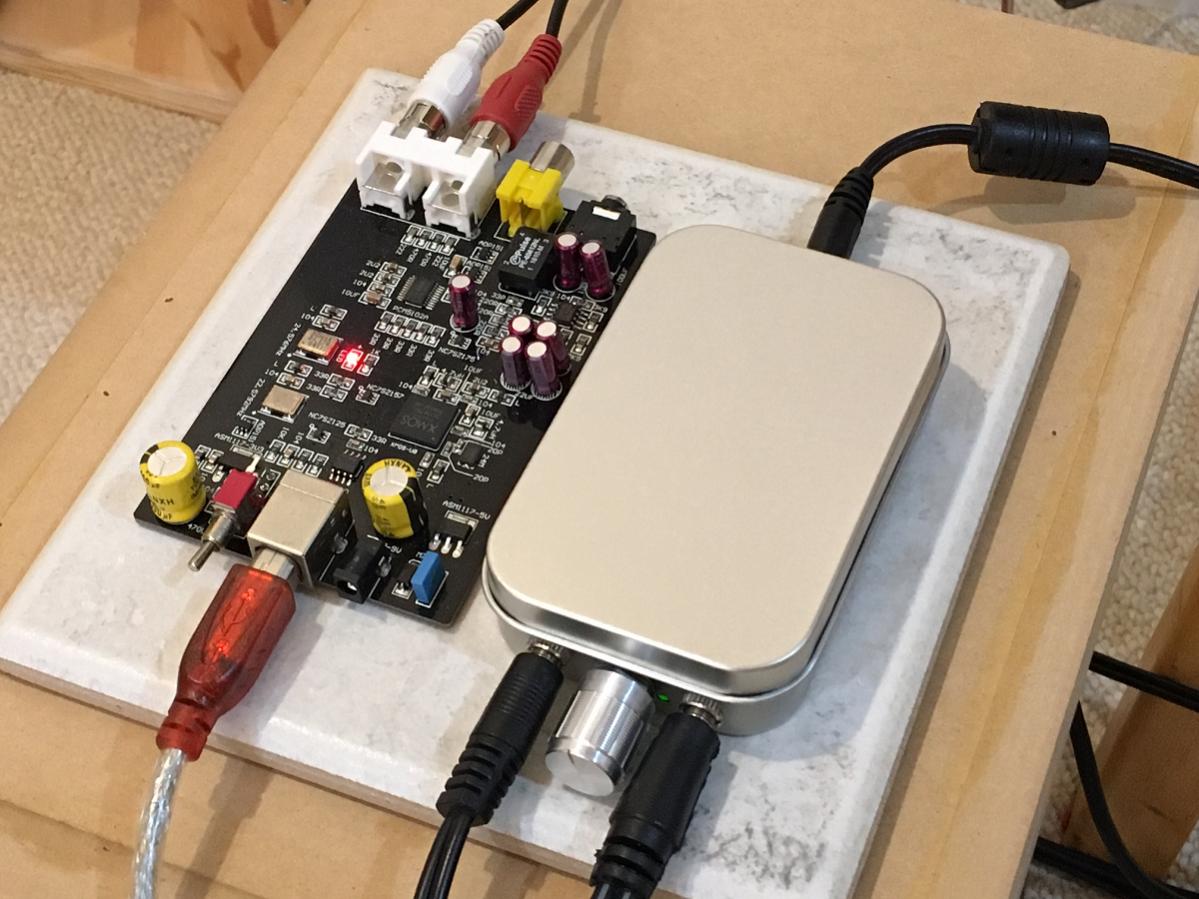
I am now using this as a workhorse preamp for my big Class AB power amps. It's a Pocket Class A but instead of 9v batteries, I have a DC-DC step up converter (1.2Mhz switch freq) and a RCRCRC (0.47R//2200uF) filter inside giving the amp a solid 17v regulated ultra-low noise power supply. I am using a 12v 3amp SMPS from an old external HDD to power it (don't need all the amps but it's what I had). Here it is sitting next to my XMOS U8//BB PCM5102A DAC. It's a nice combo - dead silent noise floor and great musicality and dynamics. With a 3ohm output impedance and ability to drive 10v peak-peak, it can pretty much drive any amplifier to clipping, all while doing so with a wonderful SE Class A harmonic profile. This particular unit has -72dB H2 and -84dB H3 and nothing else.

Attachments
ah dang. that was what i was thinking of doing haha 1000uF with 470uF silmic. I just ordered about $75 worth of caps =(
With different cap values and without the KA in the mix, who knows?
I am now using this as a workhorse preamp for my big Class AB power amps. It's a Pocket Class A but instead of 9v batteries, I have a DC-DC step up converter (1.2Mhz switch freq) and a RCRCRC (0.47R//2200uF) filter inside giving the amp a solid 17v regulated ultra-low noise power supply. I am using a 12v 3amp SMPS from an old external HDD to power it (don't need all the amps but it's what I had). Here it is sitting next to my XMOS U8//BB PCM5102A DAC. It's a nice combo - dead silent noise floor and great musicality and dynamics. With a 3ohm output impedance and ability to drive 10v peak-peak, it can pretty much drive any amplifier to clipping, all while doing so with a wonderful SE Class A harmonic profile. This particular unit has -72dB H2 and -84dB H3 and nothing else.

My musician buddy who heard this amp over the weekend requested that I build him one with a power supply so that he can use his as a preamp for PA systems while he performs DJ sets around town. Might be asking you questions about this setup down the road, X!
Say, do you feel that 17V is the sweet spot for this amp? I ask only because my OKCell batteries put out more than 18V when freshly charged...I measure over 7V bias for the first several minutes of operation. Is it a still a good idea for me to tune the bias higher with the resistor swap? At what point does H2 drop down to H3 levels? I bought several R values and haven't decided how high I want to go yet... BTW all resistors I bought for my next, "NHB" build are 0.2W Vishay MicroMELF... I saw a high-end manufacturer's website (iFi) bragging about using Silmics, MELFs, and TDK COGs in their amps and DACs, so I figured I'd go all out!
I have a DC-DC step up converter (1.2Mhz switch freq) and a RCRCRC (0.47R//2200uF) filter inside giving the amp a solid 17v regulated ultra-low noise power supply.
Given you want to filter out the switching frequency primarily (1.2MHz) why are you using electrolytics in your RCRCRC filter? They're going to be ESR and ESL limited at this frequency. In the ESR/ESL limited region of a capacitor you'll want lower ESR and ESL to get better ripple rejection, raw uF is rather secondary so why not use ceramics? Say 10uF/35V 1206 X7R. They're about 2mohm ESR at this frequency and have a SRF around 1.3MHz so you'll get maximum advantage from their self-inductance.
Good idea Abraxalito - but the built in LC filter on the DC Step up kills off the 1.2MHz just fine. However it has a broadband noise hump from DC to just below 1kHz (on FFT) that I find needs big caps to squash. I can try adding a few 10uF 50v X7R MLCC's if that might help somehow though.
My musician buddy who heard this amp over the weekend requested that I build him one with a power supply so that he can use his as a preamp for PA systems while he performs DJ sets around town. Might be asking you questions about this setup down the road, X!
Say, do you feel that 17V is the sweet spot for this amp? I ask only because my OKCell batteries put out more than 18V when freshly charged...I measure over 7V bias for the first several minutes of operation. Is it a still a good idea for me to tune the bias higher with the resistor swap? At what point does H2 drop down to H3 levels? I bought several R values and haven't decided how high I want to go yet... BTW all resistors I bought for my next, "NHB" build are 0.2W Vishay MicroMELF... I saw a high-end manufacturer's website (iFi) bragging about using Silmics, MELFs, and TDK COGs in their amps and DACs, so I figured I'd go all out!
I will post details of the internals of the RCRCRC soon. The first R is needed to limit in-rush current so step up doesn't shut down on startup.
However it has a broadband noise hump from DC to just below 1kHz (on FFT) that I find needs big caps to squash.
That sounds like a stability problem with the switching regulator itself. Do you know what chip is used in it? In which case definitely keep the electrolytics but add some MLCCs right at the start.
That sounds like a stability problem with the switching regulator itself. Do you know what chip is used in it? In which case definitely keep the electrolytics but add some MLCCs right at the start.
It's a MT3608 switcher:
MT3608 DC-DC 2V-24V Step Up Power Apply Module Booster Module 2A for Arduino | eBay

Desktop internal PSU DC boost and RCRCRCRC
I forgot it is actually an RCRCRCRC (4 caps!). Each cap is a 2200uF 25v and each R is a 0.47R 1W. The DC step up is the MT3608 as mentioned in above post. These units are little marvels of engineering and under $0.50ea. They boost AND regulate. The chip itself with proper heatsinking claims 2amps - don't believe it but 200mA seems ok. I have blown a couple up by pulling twisting the trimpot too far on the higher voltage side. The chip itself literally explodes and glows red hot and spews smoke - quite a dramatic show. So be careful when twisting the set screw CCW.
Here are some photos of the combo, you can see I wrapped the caps in black PVC tape and added Kapton tape over exposed contacts of step up board to prevent a short inside the amp case. The 5.5mm power inlet jack can be seen on the end. The DC step up is on the moment you plug it in. The amp does not turn on until the volume knob is clicked on. I leave it plugged in and on 24/7 so no need to worry about turning off. I tried 18v Vcc - it works well but generates a lot of heat as the resistor array was too hot to touch more than 2 seconds.
I will add a 10uF 50v x7r MLCC at the input right after the first 0.47R.
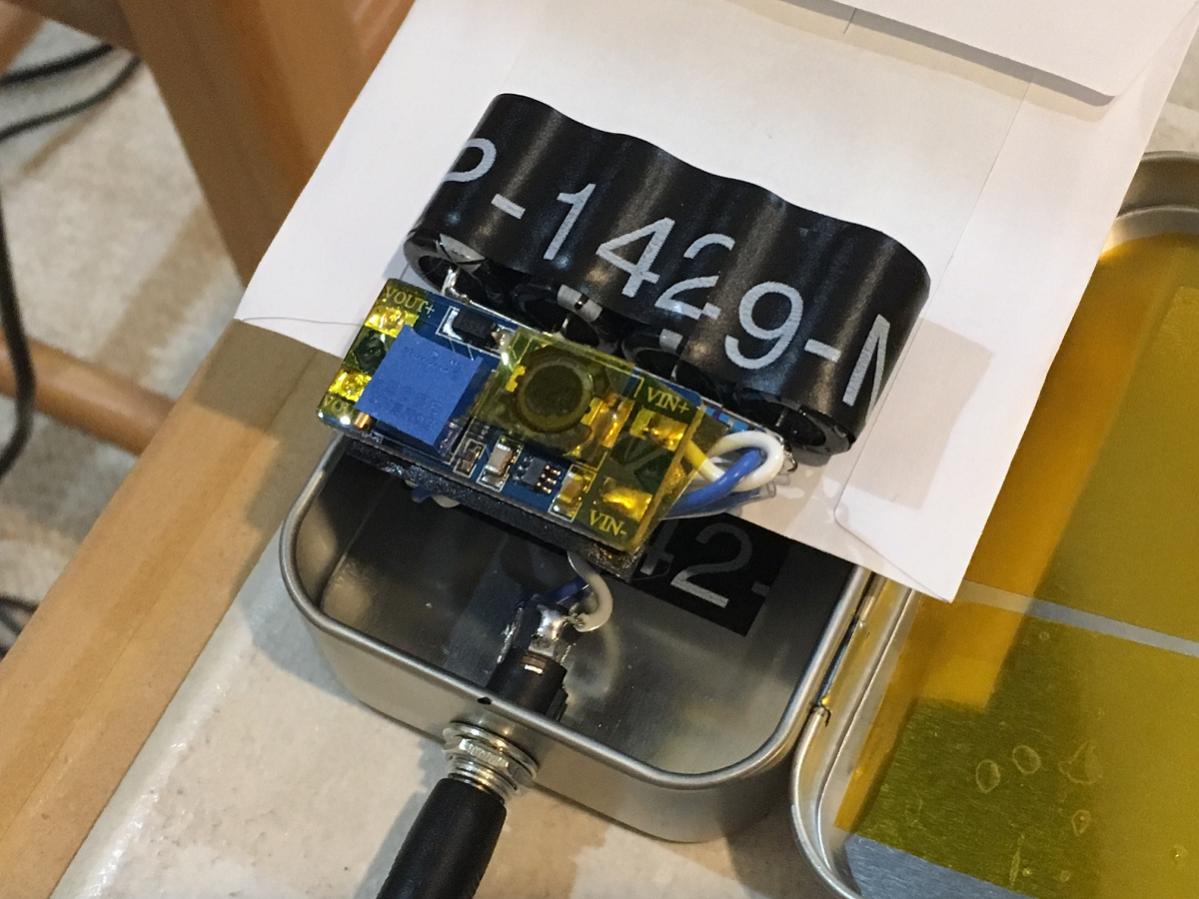
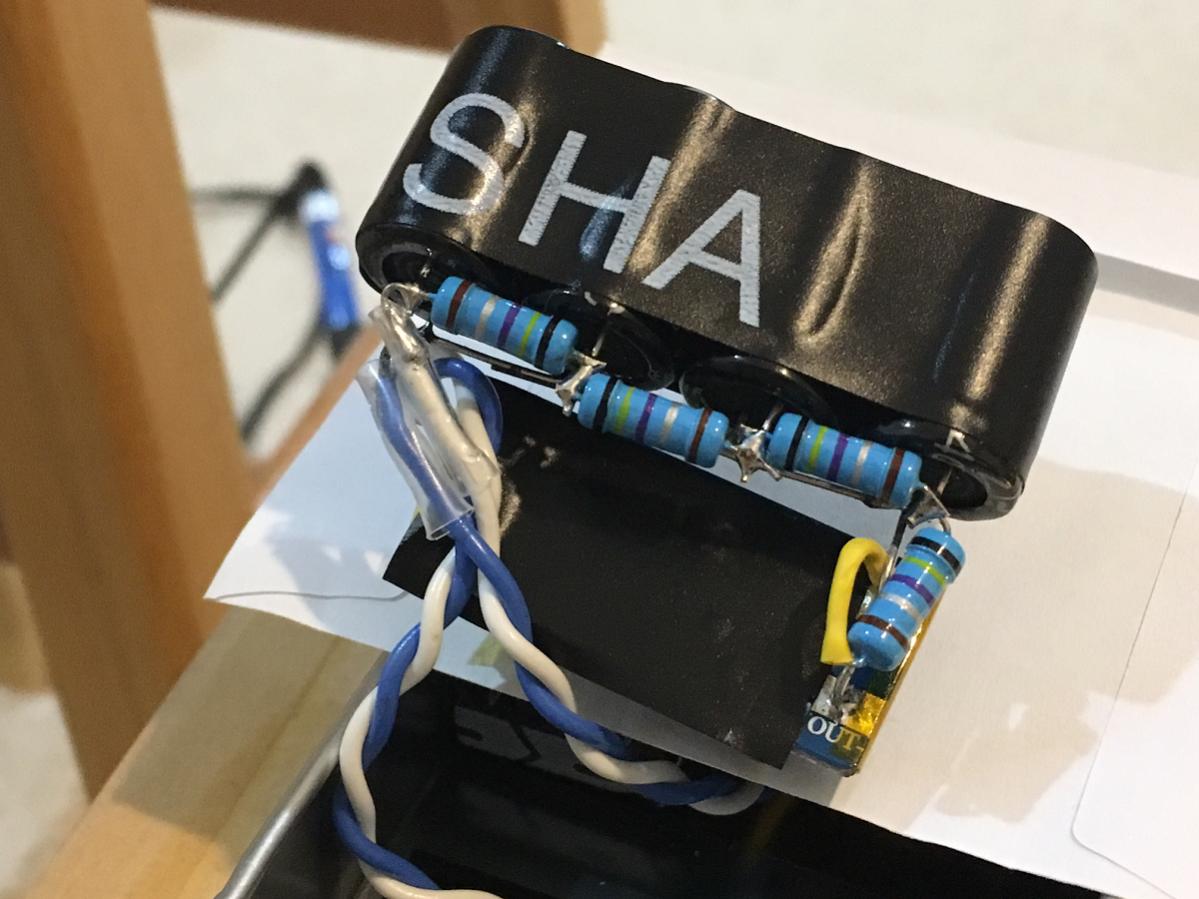
As a side note, this preamp will drive 10v peak-peak (at <0.5% THD into 270ohm load of the built in load) so should be able to handle any power amp. I always see people in Pass Forum asking same question on a variety of threads: "can this drive an F4 amp?" I guess the F4 must sound really special but it is a current amp with -0.3dB gain so it needs a powerful preamp. This pocket amp would be the perfect preamp for an F4, IMO.
I forgot it is actually an RCRCRCRC (4 caps!). Each cap is a 2200uF 25v and each R is a 0.47R 1W. The DC step up is the MT3608 as mentioned in above post. These units are little marvels of engineering and under $0.50ea. They boost AND regulate. The chip itself with proper heatsinking claims 2amps - don't believe it but 200mA seems ok. I have blown a couple up by pulling twisting the trimpot too far on the higher voltage side. The chip itself literally explodes and glows red hot and spews smoke - quite a dramatic show. So be careful when twisting the set screw CCW.
Here are some photos of the combo, you can see I wrapped the caps in black PVC tape and added Kapton tape over exposed contacts of step up board to prevent a short inside the amp case. The 5.5mm power inlet jack can be seen on the end. The DC step up is on the moment you plug it in. The amp does not turn on until the volume knob is clicked on. I leave it plugged in and on 24/7 so no need to worry about turning off. I tried 18v Vcc - it works well but generates a lot of heat as the resistor array was too hot to touch more than 2 seconds.
I will add a 10uF 50v x7r MLCC at the input right after the first 0.47R.


As a side note, this preamp will drive 10v peak-peak (at <0.5% THD into 270ohm load of the built in load) so should be able to handle any power amp. I always see people in Pass Forum asking same question on a variety of threads: "can this drive an F4 amp?" I guess the F4 must sound really special but it is a current amp with -0.3dB gain so it needs a powerful preamp. This pocket amp would be the perfect preamp for an F4, IMO.
Attachments
Last edited:
Please measure with respect to GND, DC voltage at pin 1, 2, 3 at mosfet of good and bad channel. Measure voltage drop across R3. Voltage of pin3 tells us bias current and voltage drop across R3 tells is JFET bias. When bias current is too low, you will get distortion. So a bad joint may cause low voltage which may cause audible distortion.
Thank you X for the specific pointers. Sorry, but life happened since I reported my problem.
I took my amp apart tonight and measured the said points. To my surprise the 2 channels measured almost identical. I quickly connected the source and headphones and the distortion was gone! Problem gone. So I put it back into the enclosure and when I tested it again - there was absolutely NO sound.
All is good now, and the amp sounds damn fine again! I also think that 19V is pushing it a bit. With the amp naked on the table I could hardly touch the mosfets for 2/3 seconds. So I turned down the voltage to 18V and the mosfets were running a lot cooler. It still sounded the same to me, but hopefully Stellar finds the sweet spot of this amp.
Next step is to bypass Silmics with other Silmics.
- Home
- Group Buys
- xrk971 Pocket Class A Headamp GB
